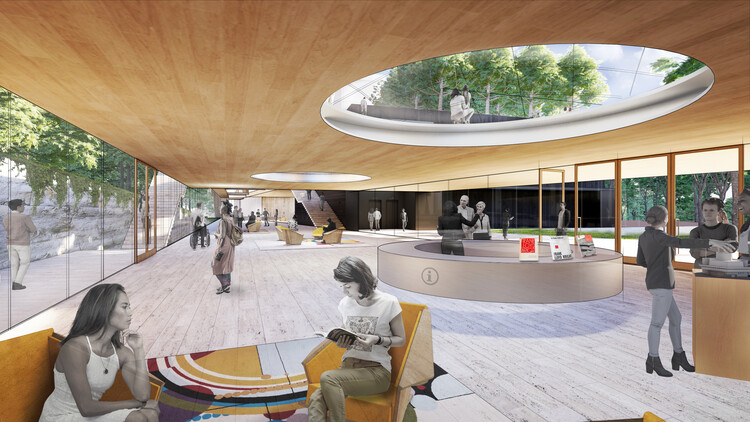
Diller Scofidio + Renfro, in collaboration with Dallas Theater Center, unveiled the design proposal for the Kalita Humphreys Theater master plan, centered around one of Frank Lloyd Wright’s lesser-known buildings. Over the years, neglect and additions have compromised the building’s integrity. The project aims to restore the mid-century theater to its original state by applying a multifaceted approach. According to the architects, this includes surgical extraction, selective reconstruction, preservation, and a faithful reinterpretation of Wright’s design intent. The master plan also aims to transform the surrounding public green space into an active and attractive park connected to Turtle Creek and Katy Trail, some of the most visited destinations in Dallas.
The intervention reimagines the public green as an open and democratic urban park, well connected to the city through a network of bridges, pedestrian walkways, and bicycle paths. It also prioritizes the position of the Kalita Humphreys Theater as the centerpiece of this revitalized landscape. In keeping with Wright’s Organic Theory of Architecture, which advocated the unification of a building with its natural setting, the Theater was initially nestled into a limestone bluff overlooking Turtle Creek. However, this setting has since been fragmented by large parking lots and roadways. While the bluffs removed as part of the 1968 addition are irrecoverable, a lightly reshaped landscape will echo the original topography of the site.

The Kalita Humphreys Theater, built to Frank Lloyd Wright’s 1959 design, has suffered a series of alterations, including a lobby extension in 1968 that compromised the original massing of the building. Some architectural details were also lost in these alternations. Still, the intervention aims to research and carefully refurbish the original elements, including mid-century light fixtures, air grilles, door handles, window moldings, and furniture.
Besides restoration, the project also needs to respond to the needs of contemporary audiences and artists. Upgraded lighting, AV, stage infrastructure, and other back-of-house functions will improve flexibility and allow for a broader range of performances. The seating scheme will resemble the 1959 auditorium, with staggered rows that improve sightlines. The campus lobby will receive a central information point and historical center to orient and engage visitors. The interventions aim to turn the neglected building into an active theater hosting a wide range of productions while honoring the beauty and integrity of Frank Lloyd Wright’s design.

New programs are also integrated into the landscape. Discrete pavilions along the public axis will be interspersed with pocket courtyards, each featuring a specific program that will amplify the social and cultural reach of the ensemble. The scale and position of the new buildings are informed by the Kalita Humphreys Theater, ensuring that the historic theater remains the focal point of the composition. A 100-seat black box theater will open onto one of the courtyards as an indoor/outdoor venue; a multipurpose pavilion will offer a flexible infrastructure for various events, educational classes, and workshops; a rehearsal and education “tower” will incubate small, immersive productions, while a restaurant completes the image of the new Kalita Humphrey Campus.

Founded in 1981, Diller Scofidio + Renfro (DS+R) are known for projects such as the College of the Holy Cross Prior Performing Arts Center in Worcester, US, and The Tide, a 5-kilometre network of public spaces and gardens embedded into the daily rhythms of Greenwich Peninsula in London, UK.












